India’s vast and vibrant landscapes are teeming with an array of wildlife that is as diverse as its culture and geography. The country’s expansive boundaries encompass a variety of ecosystems, from the towering peaks of the Himalayas in the north to the lush evergreen rainforests of the south, and from the arid sands of the Thar Desert in the west to the dense mangrove forests of the Sundarbans in the east. These habitats are home to a staggering collection of species, making India a true biodiversity hotspot within the Indomalayan realm.

The assortment of Indian fauna is a testament to the subcontinent’s natural wealth. In the thickets of national parks and the shadows of the forest canopy, majestic Bengal tigers prowl, Asiatic elephants roam, and one-horned rhinoceroses forage.
Throughout the country, there are dedicated sanctuaries and protected areas where the curious and adventurous can witness these animals and many more in their natural habitats. From the bird watchers to the big-cat enthusiasts, India’s wildlife sanctuaries promise an exhilarating encounter with nature.
Intertwined with the land and its creatures, the cultural tapestry of India adds a unique dimension to the wildlife experience. Visitors are not just treated to spectacular sightings, but also to the rich narratives and practices that have developed in harmony with nature over millennia. As they explore the national parks, like the renowned Jim Corbett or the Ranthambore Tiger Reserve, the adventurous spirits are rewarded with sights that extend beyond the natural world and into the heart of India’s heritage.
See Related: Jaguar vs Tiger: A Detailed Comparison of Two Majestic Big Cats
The Royal Bengal Tiger
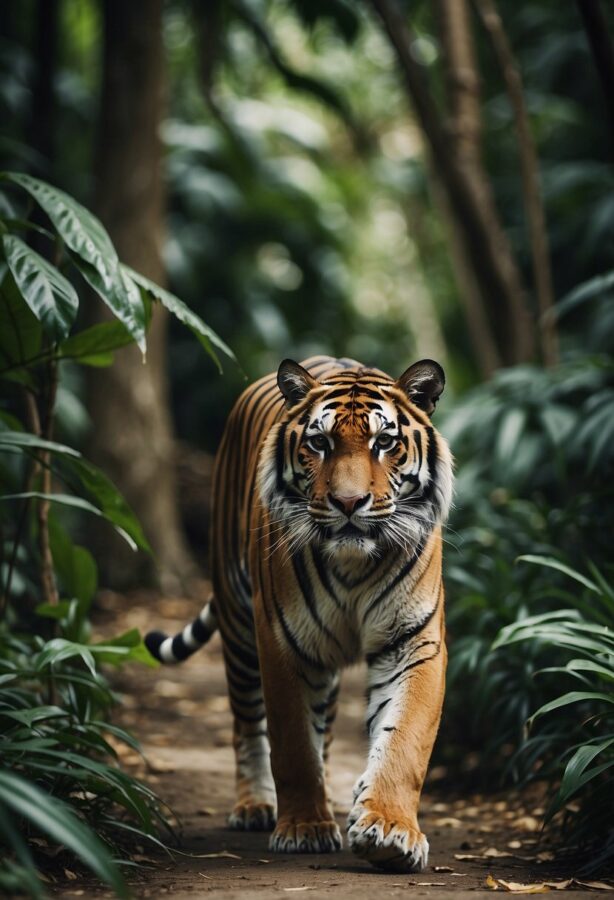
The Royal Bengal Tiger, India’s national animal, epitomizes the allure and majesty of the subcontinent’s wildlife. It has been a symbol of strength and royalty throughout India’s history and currently plays a pivotal role in the country’s conservation efforts.
Habitat
The Bengal tiger predominantly resides in India, with smaller populations in Bangladesh, Nepal, Bhutan, China, and Myanmar. In India, their habitats range from the mangrove-infested Sundarbans in West Bengal to the lush forests of Assam.
One of their most renown strongholds is Kaziranga National Park in Assam, celebrated for its significant tiger population and the conservation successes attributed to its vigilant management. Bengal tigers thrive in a variety of environments, including grasslands, subtropical and temperate forests, to mangroves. The presence of water bodies and a sufficiency of prey are common denominators across these habitats.
Conservation
The Royal Bengal Tiger is listed as an endangered species and faces several threats, predominantly from poaching and habitat loss. India’s approach to conserving this magnificent predator involves a network of national parks and wildlife reserves, strict anti-poaching laws, and community engagement initiatives.
The country’s Project Tiger, launched in 1973, seeks to preserve habitats and reduce human-tiger conflicts, contributing to the gradual increase of the tiger population in recent years. Conservation endeavors focus on achieving a balance between development and the undisturbed continuity of tiger territories to ensure the Royal Bengal Tiger continues to roam India’s forests.
The Indian Elephant
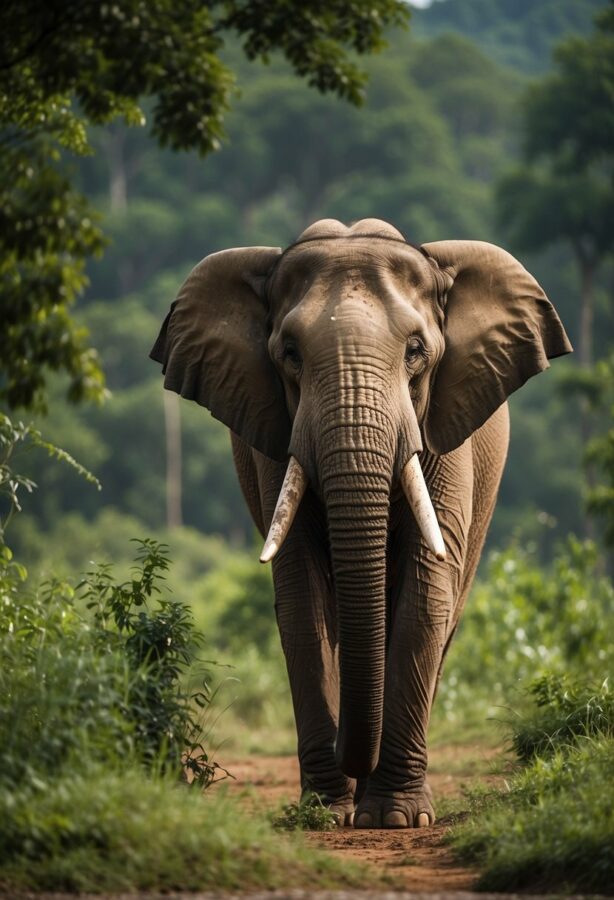
The Indian elephant, a subspecies of the Asian elephant, roams the diverse landscapes of India, captivating wildlife enthusiasts with its majestic presence. One can encounter these gentle giants across various habitats, from grasslands to forests, where they play a crucial role in the ecosystem.
Migration Patterns
Indian elephants are known for their dynamic migration patterns, which are essential for their survival. They migrate in search of food, water, and suitable breeding conditions. These elephants typically wander through a range of habitats, including subtropical broadleaf forest, tropical broadleaf moist forest, dry forest, and grasslands. During these migrations, they facilitate the dispersal of seeds, contributing to the health of the ecosystem.
The paths they follow can span up to 125 square miles. Water sources along these migration routes are critical as elephants require substantial amounts to sustain their large bodies and aid digestion.
Human-Elephant Conflict
As Indian elephants seek to traverse their traditional migratory paths, they often find themselves at odds with human populations. The expansion of human settlements and agricultural lands into elephant habitats has given rise to increasing instances of human-elephant conflict. This conflict can result in damage to crops, property, and sometimes lead to loss of human and elephant lives.
Conservation efforts are underway to mitigate these conflicts through various strategies. These include creating corridors to allow safe passage for elephants between different habitats and employing innovative solutions to deter elephants from entering human-inhabited areas.
The Great Indian Rhinoceros
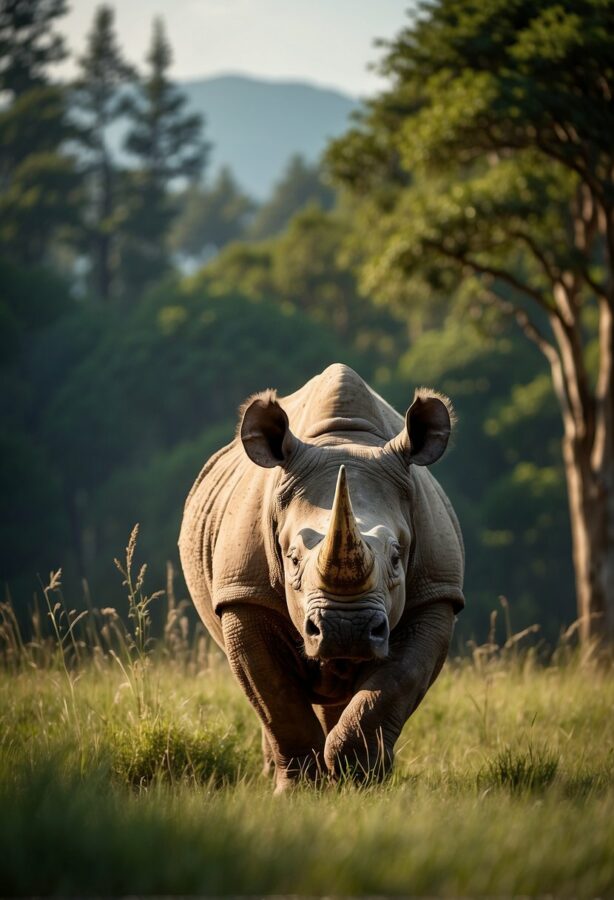
The Indian Rhinoceros, emblematic of India’s rich biological diversity, is unique with its single horn and armor-like skin folds. Once on the brink of extinction, steadfast conservation efforts have allowed their numbers to recover, highlighting India’s commitment to wildlife preservation.
Conservation Efforts
Conservation of the Indian rhinoceros has been a formidable challenge, met by significant efforts, primarily in India and Nepal. The species, listed as Vulnerable by the IUCN, has been the focus of stringent protection measures. Through the collaboration of wildlife authorities and international organizations, robust anti-poaching systems have been established.
Key initiatives include:
- Enhanced surveillance and monitoring of rhinoceros populations
- Stringent anti-poaching laws and proactive law enforcement
- Habitat management strategies to ensure undisturbed breeding grounds
- Community involvement to align local interest with wildlife conservation
India has played a significant role in these efforts, leading to a steady growth in rhino numbers, now exceeding 3,700 individuals in the wild.
Protected Areas
Protected areas are sanctuaries, not only for the great Indian rhinoceros but also for a myriad of other species coexisting in these biodiverse regions.
Prominent among the rhinoceros’ natural habitat is:
Protected Area | Features |
|---|---|
Kaziranga National Park | A UNESCO World Heritage Site, renowned for its substantial population of the Indian rhinoceros. It spans grasslands, wetlands, and forests. |
Pobitora Wildlife Sanctuary | Although smaller, this sanctuary boasts the densest rhino population on the planet. |
Manas National Park | A region recovering from historical pressures, now teeming with wildlife, including the Indian rhino. |
These havens, primarily in the northeastern part of India, offer adventurous souls the opportunity to witness the Indian rhinoceros amid lush grasslands and verdant rainforests, underlining India’s vast terrain diversity – a perfect confluence for enthusiasts seeking to witness majestic wildlife in their natural domain.
The Indian Leopard
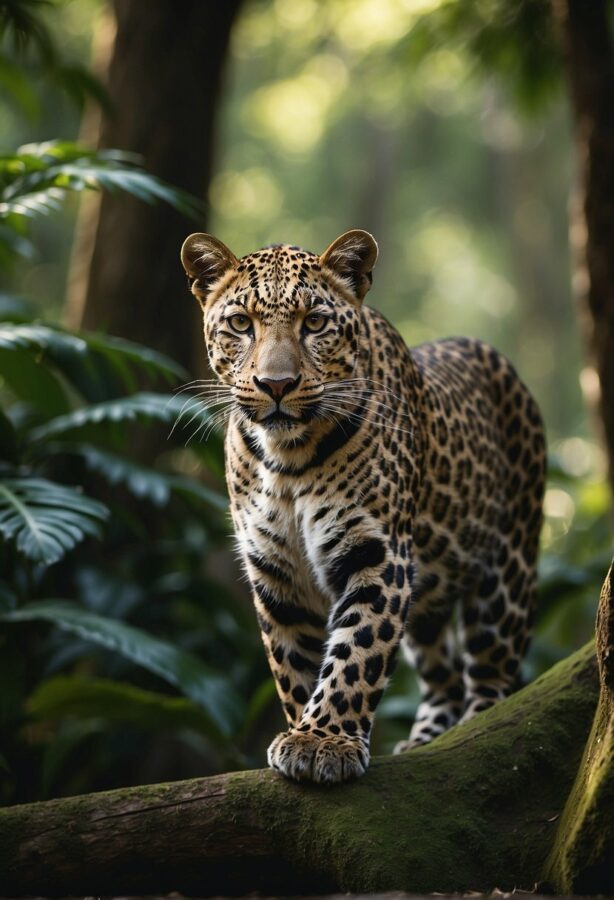
The Indian Leopard, or Panthera pardus fusca, is a notable predator in India’s vibrant wildlife, adept at navigating a range of habitats and facing challenges from habitat loss and human conflicts.
Leopard Habitats
Indian forests boast a variety of ecosystems, each home to this adaptive big cat. They thrive in dense tropical rainforests, deciduous forests, and arid regions, illustrating their remarkable ecological versatility. Sightings are more prevalent in wildlife sanctuaries and protected areas, where they have a better chance of survival away from the growing human footprint.
- Tropical Rainforests: Lush and dense, offering ample coverage for stealth.
- Deciduous Forests: Seasonally changing, providing varied hunting grounds.
- Arid Regions: Dry and sparse, yet still supporting leopard populations.
Wildlife enthusiasts often embark on safaris in regions like Jim Corbett and Gir Forest National Park with the hope of glimpsing these elusive predators amidst the grandeur of Indian wilderness.
Man-Leopard Conflicts
As human populations expand, the instances of conflict between the Indian leopard and people have risen. Encroachment into forested areas is shrinking their natural habitat, leading to leopards venturing into human-dominated landscapes in search of territory and prey. This interaction sometimes results in loss of livestock for local communities and, in worst-case scenarios, human fatalities, which can provoke retaliatory killings of leopards.
- Habitat Encroachment: The main driver pushing leopards into human spaces.
- Livestock Predation: A survival tactic for leopards that causes human hostility.
- Retaliatory Killings: A grave threat to the leopard population’s stability.
Efforts are being made to mitigate this conflict through better management practices, creating corridors for wildlife movement, and raising public awareness about coexistence strategies.
The Gharial

The Gharial, often encountered along the riverbanks within India’s national parks, presents a remarkable sight with its distinctive elongated snout and conical teeth, inviting adventurers to explore the realm of one of the most specialized river predators.
Gharial in Indian Rivers
The Gharial (Gavialis gangeticus) can be found in the flowing rivers of India, prominently including the sacred Ganges. They prefer the calm and depth of the river’s slower-moving areas where they can bask and hunt, with a diet predominantly consisting of fish. Adventurers seeking to observe these reptiles can visit sanctuaries and protected areas where they may also encounter other riverine species like the Ganges river dolphin.
Habitats of the Gharial:
- Chambal River: A key sanctuary offering a safe haven for gharials.
- Other Rivers: Gharials also inhabit the Gandak, Son, and Mahanadi rivers.
Conservation Status
The gharial is listed as Critically Endangered on the IUCN Red List, with conservation efforts focusing on habitat preservation. Poaching and loss of riverine habitat due to human activity have dramatically reduced their populations.
Conservation organizations and wildlife trusts are engaged in various projects, ensuring that these unique crocodiles can continue to thrive in their natural habitats. Safeguarding the gharial also supports the protection of co-inhabitants like the endangered Ganges river dolphin, contributing to the health and diversity of the river ecosystems.
The Nilgai
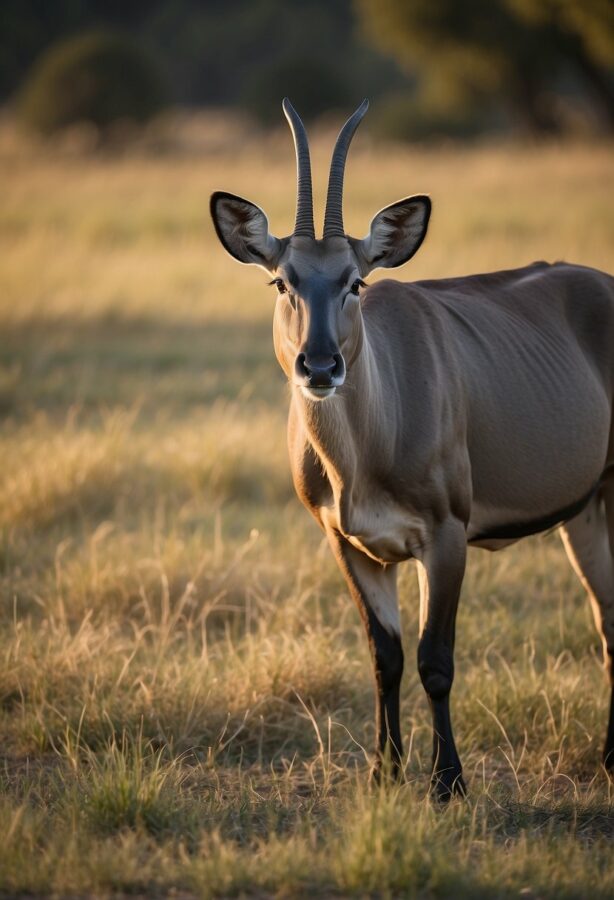
The Nilgai, also known as the blue bull, is the largest antelope in Asia, thriving in the grasslands and farmlands of the Indian subcontinent. They hold a significant place in Indian culture and are a fascinating species for wildlife enthusiasts.
See Related: A Guide to Animals in Antarctica: Wildlife on a Frozen Continent
Nilgai Behavior
Nilgai are creatures of habit, generally found in small groups, although older males tend to be solitary. Their behavior is largely influenced by the environment, with grasslands offering ample grazing opportunities.
Males are distinguishable by their robust size and distinct bluish-grey coat, earning them the colloquial name “blue bull”. In contrast, females and juveniles are tawny-brown.
- Diet: Primarily grazers, their diet consists of grasses, leaves, and buds.
- Activity: They are most active during the cooler parts of the day, namely dawn and dusk.
Nilgai and Agriculture
Nilgai’s impact on agriculture is a controversial topic in regions where they are populous. These antelopes adapt well to cultivated areas, which often leads to them venturing into farmlands, creating a point of conflict with local farmers.
- Conflict: Nilgai may consume or trample crops, leading to economic losses for farmers.
- Management: Efforts such as fencing and crop selection are implemented to mitigate human-nilgai conflicts.
India’s diverse ecosystems offer a broad array of habitats for wildlife, making it an adventurous destination for observing species like the Nilgai. Visitors may catch a glimpse of these large antelopes amid the backdrop of India’s vast grasslands or while exploring its numerous wildlife sanctuaries and national parks.
The Indian Bison
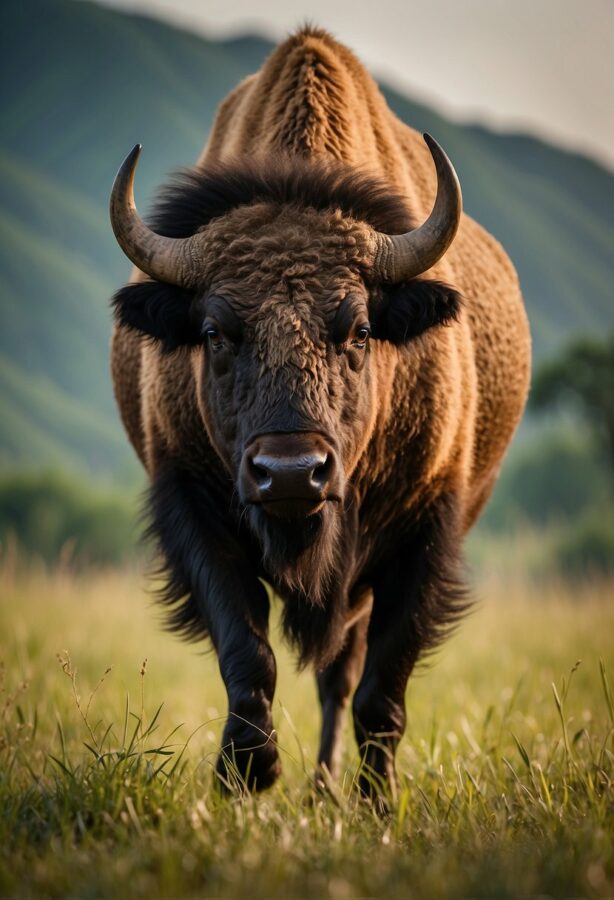
The Indian Bison, commonly known as the Gaur, is a majestic and robust species of wild cattle endemic to the forests of South Asia, particularly the Western Ghats. Their conservation status has invoked significant attention due to their dwindling numbers.
Bison in the Wild
The Gaur (Bos gaurus) thrives in the diverse ecosystems of India, from the deciduous forests teeming with flora and fauna to the evergreen woodlands of the Western Ghats. They are distinguished as the largest species among the Bovidae family, with males weighing between 600 kg to 1500 kg and adult females weighing about 400 kg to 1000 kg.
The forests they inhabit boast a rich biodiversity, offering wildlife enthusiasts an adventurous escapade. Sightings of the Indian Bison in their natural habitat, lumbering through the undergrowth or grazing in serene clearings, are a compelling draw for visitors to these regions.
- Preferred Habitats: Deciduous and Evergreen Forests
- Prominent Features: Massive build, convex forehead ridge, sturdy limbs
- Key Locations: Western Ghats, certain protected areas in India
Human-Bison Interactions
Interactions between humans and the Indian Bison have been historically rich, though not without challenges. They have cultural significance in various local communities, but the expansion of human settlements and changes in land use have led to habitat reduction. Efforts to mitigate conflict include promoting sustainable tourism that respects the Gaur’s habitat while still indulging the adventurous spirit of travelers. Conservation initiatives strive to balance the needs of local communities with the imperatives of protecting these wild beings and their forest homes.
- Conservation Status: Vulnerable
- Notable Incidents: Habitat encroachment, Human-Bison confrontations
- Conservation Efforts: Sustainable tourism, Habitat protection programs
The Snow Leopard

The elusive snow leopard, a symbol of the mystical Himalayas, thrives in India’s rugged high altitudes, representing a key species in the region’s ecological web. Their presence marks regions such as Ladakh as critical habitats for wildlife conservation, highlighting the intersection of biodiversity and adventure in India’s wilderness.
Habitat and Range
Snow leopards make their home in the cold, steep areas of the Himalayas, where they are expertly adapted to the harsh environment. One can find these majestic creatures across multiple wildlife sanctuaries in the Indian states, with Ladakh being a significant stronghold.
- Key Habitats Include:
- Hemis National Park, Ladakh
- Kibber Wildlife Sanctuary, Himachal Pradesh
- Gangotri National Park, Uttarakhand
They roam a territory that spans several countries, but in India, they are typically found above 3,000 meters in the snowy peaks and rugged landscapes.
Threats to Survival
The survival of snow leopards is under threat from various anthropogenic and environmental factors. Key threats include:
- Poaching: For their fur and body parts, often driven by illegal wildlife trade.
- Retaliation: By local herders due to predation on livestock.
- Habitat Destruction: Due to infrastructure development and climate change.
Conservation Efforts in India involve legal protection, with the snow leopard listed under Schedule I of the Wildlife (Protection) Act, 1972, signifying the highest degree of protection afforded to a species. Robust scientific assessments estimate India’s snow leopard population at around 718 individuals, providing foundational data for ongoing conservation strategies.
The Indian Peafowl
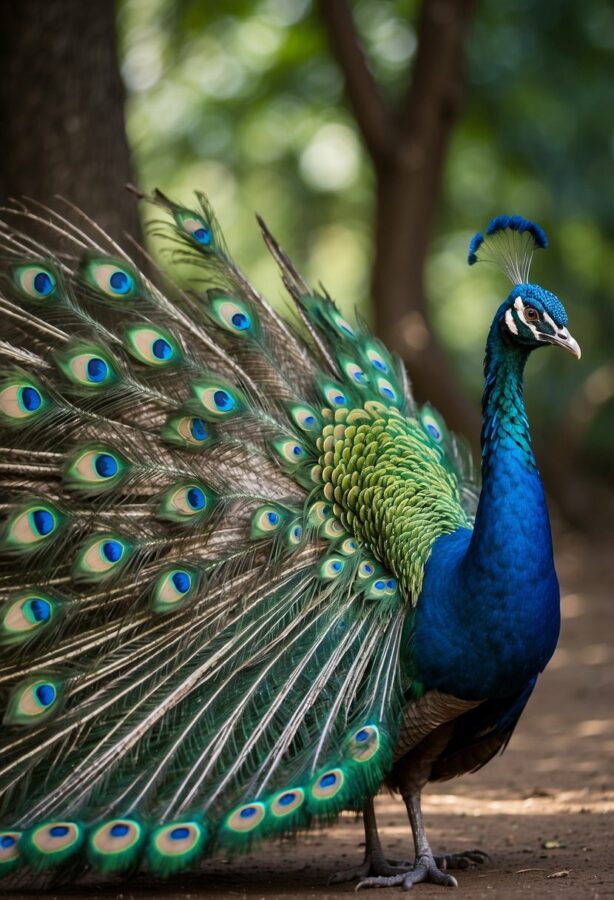
The Indian Peafowl, known for its stunning plumage and elegant display, is not only a spectacle of the avian world but also holds a revered position in Indian culture. As India’s national bird, the peafowl symbolizes the rich tapestry of India’s wildlife and cultural heritage.
See Related: Top Most Interesting Animals in the World
Significance in Indian Culture
The Indian Peafowl, commonly referred to as the peacock, is deeply engrained in the cultural fabric of India. They embody grace and beauty, often appearing in various religious and mythological representations. This bird is associated with various deities in Hinduism, such as Saraswati, the goddess of wisdom, and Kartikeya, the god of war, signifying purity, sanctity, and the cycle of rebirth.
Peafowl Across the Country
Indian Peafowls are prevalent throughout the Indian subcontinent, making their homes in the diverse regions from semi-desert grasslands to lush forests. Birds enthusiasts can encounter these majestic creatures in numerous national parks and wildlife sanctuaries across India. Some notable havens where one can witness the peacock in its natural habitat include:
- Ranthambore National Park, Rajasthan
- Keoladeo Ghana Bird Sanctuary, Bharatpur
- Jim Corbett National Park, Uttarakhand
Birdwatchers may find themselves enthralled by the male peacock’s iridescent blue and green plumage and its iconic fan-shaped crest of feathers during the display to attract mates. Their haunting calls often echo through the forests, adding an air of adventure to the experience of spotting these birds in India.
The Asiatic Lion
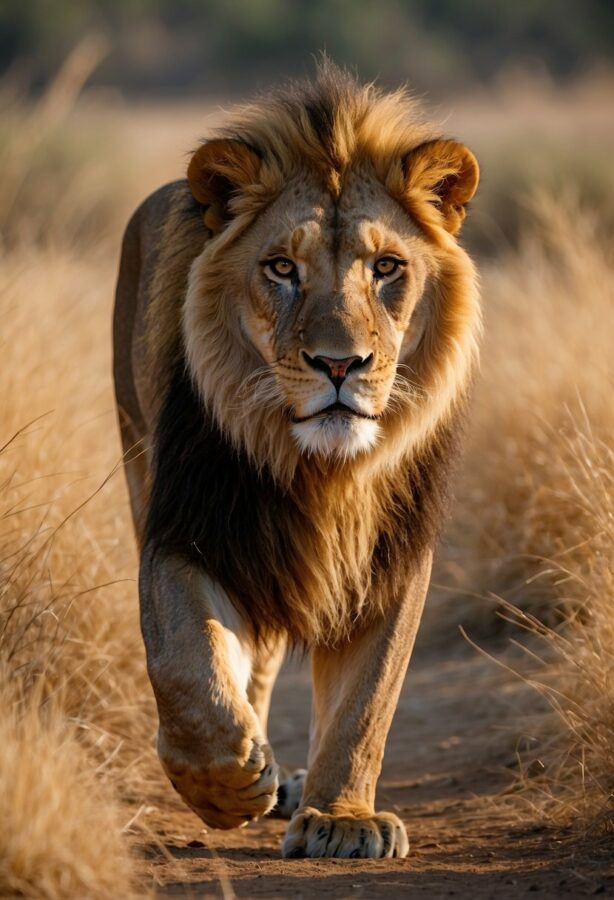
In the diverse tapestry of Indian wildlife, the Asiatic lion stands out as a beacon of successful conservation, with its last bastion situated in the Gir Forest of Gujarat.
The Lions of Gir
The Gir Forest National Park, spanning a diverse territory in the Indian state of Gujarat, is the sole home of the Asiatic lion (Panthera leo persica). Once on the brink of extinction, these majestic creatures have been given a second chance thanks to concerted conservation efforts. Here, they roam in a habitat comprising dry deciduous forest, grasslands, and scrub lands.
Visitors to Gir can witness the lions in their natural surroundings, which creates an aura of thrilling anticipation. Travelers from around the globe flock here, seeking the thrill of spotting one of these rare beasts in the wild, a sight to remember for a lifetime.
- Population: According to the snippets, they are the only surviving wild population of the species.
- Distinct Features: Adult males have an average weight between 160 to 190 kg while females weigh lighter at 110 to 120 kg. Their shoulder height is approximately 3.5 ft.
Future of the Asiatic Lion
The future of the Asiatic lion hinges on continued and enhanced wildlife conservation efforts. Their existence, confined to Gir and its environs, makes their population vulnerable to diseases and genetic bottlenecks.
Protecting the genetic diversity of this subspecies is paramount and requires meticulous management strategies, including possibly establishing a second, geographically separate population as a safeguard against potential disasters. Empowering the local communities in conservation, combating poaching, and addressing human-lion conflicts are pivotal in scripting the future chapters of the Asiatic lion’s survival saga.
- Conservation Status: These lions are not out of the woods yet, as conservationists continue to monitor their numbers.
- Threats and Challenges: Human encroachment and disease remain potential threats to their delicate comeback.
Related Resources: